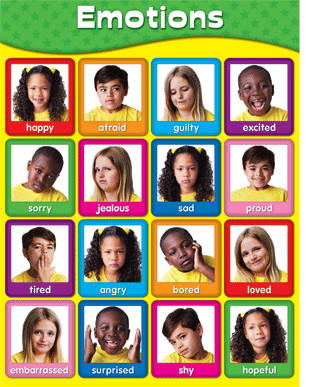Emotions - For, or
against you?

So, OK, most of us have some
sort of sense about what emotions are, BUT as we often do, let's
start with a definition.
B.gif)
Emotion
(noun): a strong feeling deriving from one’s
circumstances, mood, or relationships with others:
So an emotion is a "feeling,"
and we can distinguish it from a "thought," which is the other
thing that occurs in the mind.
Question:
Now, you wonder, why are we bringing this up, more
specifically, why this question about whether emotions are for
you, or against you?
The short
answer: Emotions work both ways, so it is important to
see how that happens.
Right,
some might say, there are negative emotions that we don't like
and positive ones that we do like. Simple as that.
Wrong,
we would say, they ALL can be positive at times and they ALL can
be negative at times, and we intend to show how.
Some basic
background information:
First, we aren't going to
discuss the idea that we like some emotions and dislike others.
Our intent here is to show how we can like ALL of them at times,
namely when they work FOR us, and dislike them ALL at times,
namely when they work against us.
Second, there are lots of
theories of emotions. These have to do with when and why
and how they arise. We aren't going to go into them, but
you certainly can look them up online.
Third, for the purposes of
our discussion here, we are going to provide ways to categorize emotion:
I. Types of
emotions: proactive & reactive
Proactive emotions
are feelings that lead to action (behavior), and they are often
referred to as drives, or motivation. They include such things
as hunger, thirst, aggression, avoidance, survival, love and
sex.
Reactive emotions are those that arise in response
to events and situations occurring in the environment. They
include such things happiness, contentment, joy, anger, fear,
and sorrow.
Development of reactive
emotions:
Infants do not have the full
repertoire of emotions at birth. Various emotions emerge in the
following order:
1. At birth: infants
experience only simple emotional states such as distress,
contentment and interest.
2. Two to four months:
Evidence of happiness appears as seen in a baby’s “social
smile.”
3. Four to six months: Basic
emotions emerge, including fear, excitement, anger, disgust,
surprise, joy and sadness.
4. Six to 18 months: Basic
emotions continue to develop and are expressed in broader ways
by the child.
5. Eighteen to 24 months:
Self-conscious emotions develop, such as guilt, embarrassment
and pride.
These two types of feelings
(proactive and reactive) are not isolated from each other. They
can lead from one to the other. For example, anger can lead to
aggression.
II. Positive
role of emotions:
Emotions have a positive role in human existence. They benefit
the person. For example, the reactive emotions of anger and fear
are two that arise in the presence of threat, and they can
assist in dealing with potential harm. So, for example, fear
keeps people from playing hop-scotch on the freeway.
II. Dysfunctional emotionality
Emotions can become dysfunctional, at which point they have a
negative role in human functioning.
This can happen several ways. For example, they can turn from
positive to dysfunctional. They can occur unnecessarily.
They can come to dominate a person’s emotional life. They can
become fixated. And so on.
Here's a short story we made
up to exemplify how an emotional response can work against a
person:

We fully recognize that this
story is not all that realistic, but we made it up in order to
show how an emotional response, in the case terror, can start
off working for a person but then move on to working against the
person. Fear causes Bill to run back to his cabin, thereby
saving his life. But then fear leads him to erect such a
defense that he loses the ability to see that there comes a time
when he need no longer fear, because over time the threat (the
bear) is gone.
In other words, Bill lost
his ability to see reality. His emotion-based defense kept
him from seeing it.
Moral of the story:
When emotions work
against us, they can limit our ability to do a reality check.
So, of course, we want folks to be able to feel their emotions,
use them for their own benefit, but recognize that it remains
important to continually check reality, to see if and when the
emotional response is no longer necessary.
Neurological Issues:
We can't end this
discussion of emotions without addressing how the nervous system
affects some emotions.
Neuropsychologists and
neurologists tell us that some emotions arise in the central
nervous system and appear more under conscious control.
Others arise in a portion of the peripheral nervous system,
specifically the autonomic nervous system, and while we can
apply conscious control to them, they initially arise almost
reflexively.
Autonomic nervous system:
There are two subsystems in the autonomic nervous system, the
sympathetic and the parasympathetic, and they cannot operate
simultaneously. In other words, when the sympathetic
nervous system is activated, the parasympathetic nervous system
cannot function, and vice versa.
Parasympathetic system:
Responsible for "rest-and-digest" or "feed and breed" activities
that occur when the body is at rest, especially after eating,
including sexual arousal, salivation, crying, urination,
digestion and defecation/
Sympathetic system: In
contrast to that, the sympathetic nervous system is responsible
for stimulating activities associated with the fight-or-flight
response.
Fear and Anger:
We brought all of this up, because these are two emotions that
are often seen as problematic, one way or another. So we
want to point out that both are designed for self-preservation.
They are inborn and automatic responses to perceived threat.
Fear seeks to escape (flight) the threat, while anger (also
aggression) seeks to negate the threat via attack (fight).
Choosing anger over fear:
One of the things that we have to do when we perceive threat is
quickly decide, fight or flight. Interestingly, there are
those amongst us who see flight (i.e., fear) as a weakness,
folks who prefer anger. One reason often is the notion
that it is best to attack and eradicate a threat than to flee
is, since it will still be there after one escapes. But
others do not see fear/flight as a weakness and will
choose not to attack but escape to plan for the best way to
eliminate or avoid the threat in the future.
Emotional
Intelligence:
This is a topic we discuss
more fully on another page of this web site, one we recommend
you read, because emotional intelligence has to do with how well
emotions work for us. The higher our Emotional Quotient (EQ),
the better they work.
 To
read about Emotional Intelligence
To
read about Emotional Intelligence
 To
read about empathy
To
read about empathy
 To
go to the Articles Page
To
go to the Articles Page